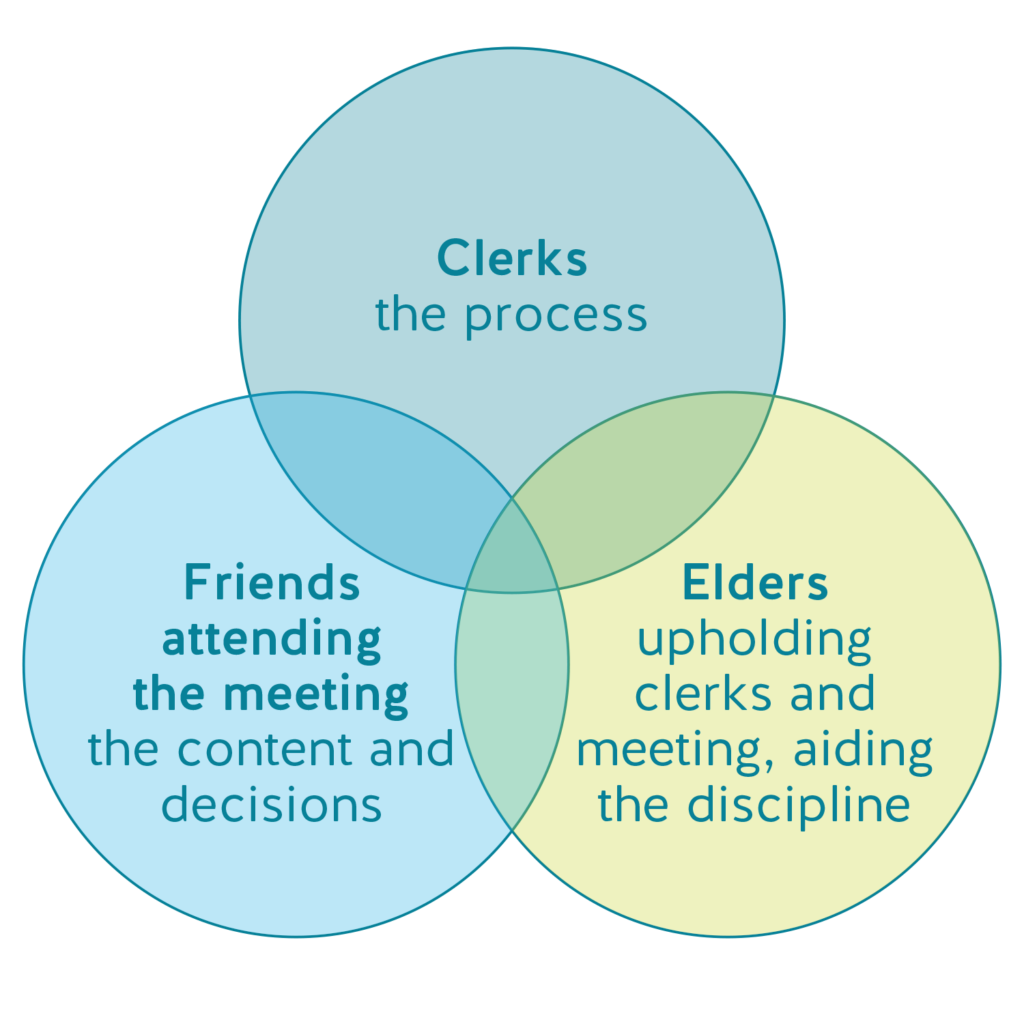Presiding at the table is the most visible aspect to Quaker clerking and the part of the role that most people notice. It’s also the part that many Friends say they could never do! But experienced clerks tell us it is a real privilege to serve in this way. We aim to help you do so much more than merely ‘cope’.
Presenting the draft agenda
At the start of the meeting you will ensure that the agenda is visible to everyone. This is the moment to ask for the meeting’s approval. Not all clerks do that but many feel it is good practice. Members of the meeting might ask for a slightly different order, for example, or an item may be withdrawn if it is not ready or key information is missing. Once you have agreement the meeting will have a sense of ownership of the work that is before them.
Sharing of responsibility
This section looks at some tricky moments that aren’t solely dependent on what the clerk can or should do in certain circumstances. The principle to hold in mind is the three-way sharing of responsibility: the clerks are responsible for the process of the meeting, the meeting is collectively responsible for the content, and the elders are responsible for aiding in keeping the discipline and in upholding the clerks and the meeting.
The 3-way sharing of responsibility with your meeting

If you hold this sharing carefully in mind it will help you work out what is yours to decide on or change, and what is not your area of responsibility. Most certainly you are there to do what the meeting wants, and to that end you really have to work to put your own feelings and opinions safely away in a box.
Clerks should try not to steer the meeting in one particular direction but remain open to many directions the meeting might be led. There can sometimes be a tussle during minute drafting, but if the meeting as an entity (that is to say, more than one influential Friend with a confident voice) wants something in the minute it’s your responsibility to note it down – through politely clenched teeth if necessary. If it seems to you that the sense of the meeting isn’t in unity with the apparent direction, someone will probably be led to say something on those lines if you allow enough time for the Spirit to dictate the pace. But if your meeting is being particularly passive at that point you can always ask them directly: ‘do you want this added in that way?’. A silence can be read as a Quaker ‘yes’.
Support from Elders
Some clerks are grateful if elders step in if discipline is getting a bit ragged, or there are inexperienced Friends present who are still learning that the QBM is different from many secular meetings in that we don’t discuss by debating. There can be a little bit of a tussle between elders and clerks if you haven’t had conversations together before the start over how much intervention works for you and how much would take away your authority as clerk.
If you think that is happening, you could ask elders to talk generally to the meeting at some point about Friends’ methods in business meetings so that individual Friends don’t feel got at. Then if things start to get heated you can remind Friends of the general guidelines they heard from elders: for Friends to try and only speak once or occasionally on each topic, leave a silent gap so everyone can reflect on the latest speaker before asking to make a new piece of spoken ministry, not repeating what has been offered previously.
The steps of proceeding through an item
The established sequence of taking the meeting through an agenda item goes like this:
- The clerk introduces the item, possibly adding in the contribution of a Friend with particular knowledge who is alerted to be ready to speak to the item.
- The clerk invites the meeting to consider the issue, eventually coming to an outcome and/or decision.
- The clerk(s) prepare the text of a minute, probably adding in new information based on the discussion that has just taken place.
- The meeting considers the suggested draft, and individuals may suggest improvements or additions.
- The clerk adds those and checks by asking the meeting if the draft is acceptable to the meeting, holding an enquiring silence to see if that really is the meeting’s wish.
- The meeting may be ready to say ‘I hope so’, but individual Friends may yet be led to stand and offer ministry that could lead a different way.
- The clerk waits in silence to be guided by the meeting.
- There may be a new version of the draft to be put to the meeting at this point, then…
- The clerk may say words similar to: ‘Is the minute now acceptable?’
- At this point the silence could be interpreted as agreement if nobody else speaks or there may be a further gentle chorus of ‘I hope so’.The clerk will judge that agreement has taken place for both the substance and the wording of the minute. That concludes the sequence for that agenda item and the text of the minute cannot later be changed.
